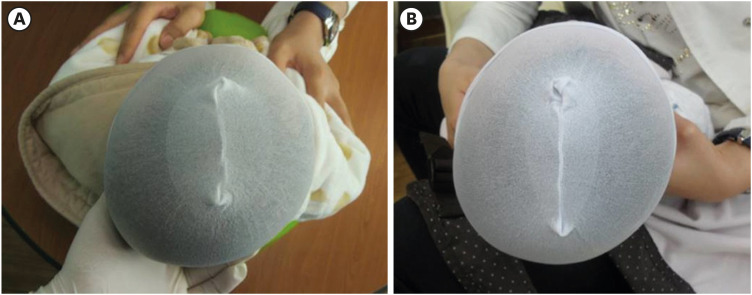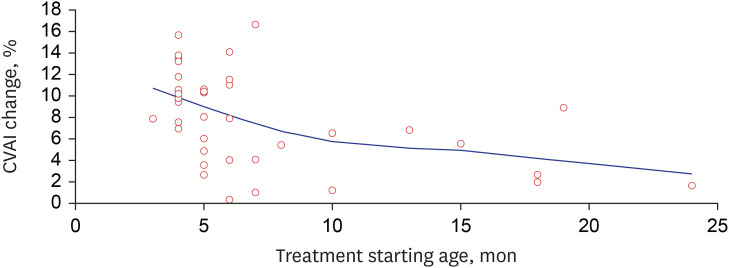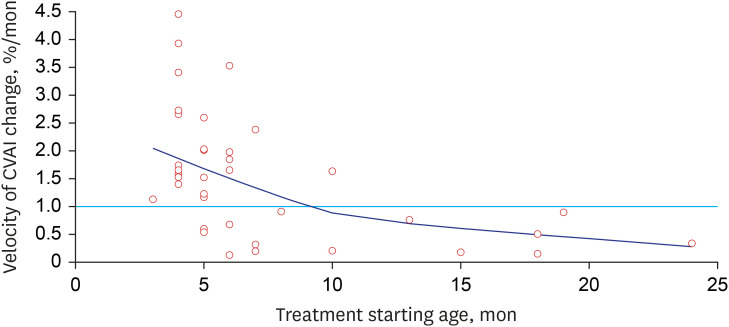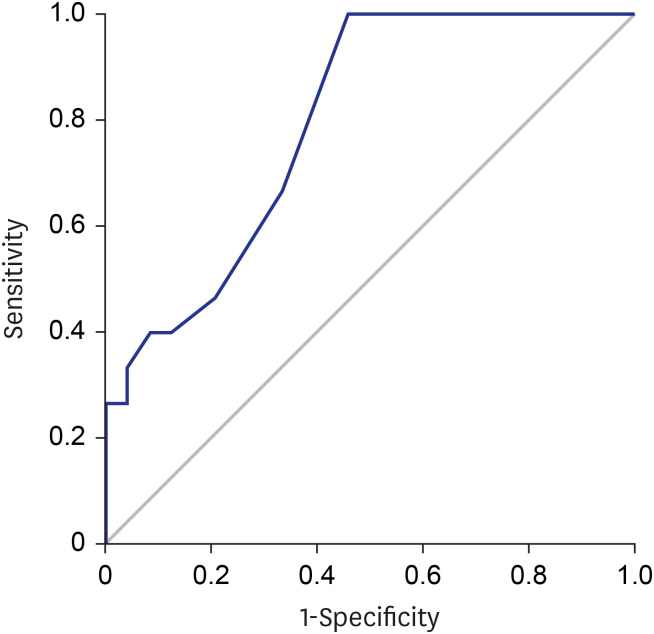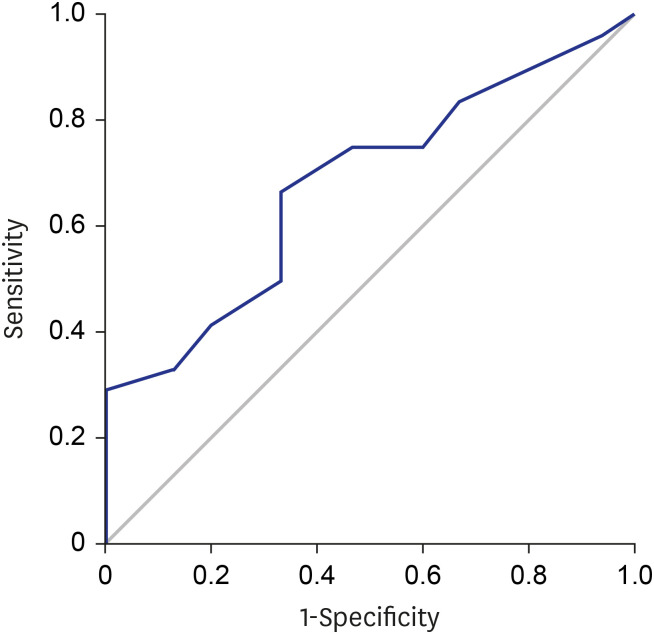J Korean Med Sci.
2020 Sep;35(36):e295. 10.3346/jkms.2020.35.e295.
Applicative Factors of Helmet Molding Therapy in Late-diagnosed Positional Plagiocephaly
- Affiliations
-
- 1Department of Plastic and Reconstructive Surgery, Ajou University School of Medicine, Suwon, Korea
- 2Department of Plastic and Reconstructive Surgery, Asan Medical Center, Uiversity of Ulsan College of Medicine, Seoul, Korea
- 3Department of Plastic and Reconstructive Surgery, Yonsei Medical Center, University of Yonsei College of Medicine, Seoul, Korea
- KMID: 2506539
- DOI: http://doi.org/10.3346/jkms.2020.35.e295
Abstract
- Background
Although the benefits of helmet therapy for positional plagiocephaly are strongly correlated with age, the effective period remains controversial. However, most physicians agree that effective results can be obtained in patients within the age of 6 months. Owing to the characteristics of positional plagiocephaly in Koreans, many Korean patients have delayed diagnosis, and because this results in delayed onset of the helmet therapy, the outcomes remain largely underevaluated. In the management of late-diagnosed positional plagiocephaly, we aimed to determine the factors affecting the effective application of helmet therapy.
Methods
We recruited 39 consecutive patients with positional plagiocephaly who received helmet therapy and completed the treatment between December 2008 and June 2016. The ages at initiation and completion of treatment, duration of daily use, initial and final absolute diagonal differences, cephalic index, and cranial vault asymmetry index (CVAI) were analysed using data retrospectively collected from the patients' medical records.
Results
We identified 12 patients with late-diagnosed positional plagiocephaly, of whom 83.33% were effectively treated. The effective change in CVAI (%) was affected by age at treatment initiation (P= 0.001), initial absolute diagonal distance differences (P < 0.001), and initial CVAI (P < 0.001). Up to 9 months, a gradual change of at least 1% CVAI was attained. Treatment initiation at ages < 5.5 months was beneficial. Even at a later age, patients with an initial absolute diagonal distance difference of > 13.50 mm and initial CVAI of > 11.03% could receive effective helmet therapy.
Conclusion
The efficacy of helmet therapy in late-diagnosed patients can be predicted on the basis of not only age at treatment initiation, but also initial absolute diagonal distance differences and initial CVAI. We anticipate that even patients with late-diagnosed positional plagiocephaly can expect better helmet therapy outcomes.
Figure
Reference
-
1. Mawji A, Vollman AR, Fung T, Hatfield J, McNeil DA, Sauvé R. Risk factors for positional plagiocephaly and appropriate time frames for prevention messaging. Paediatr Child Health. 2014; 19(8):423–427. PMID: 25382999.
Article2. Bialocerkowski AE, Vladusic SL, Wei Ng C. Prevalence, risk factors, and natural history of positional plagiocephaly: a systematic review. Dev Med Child Neurol. 2008; 50(8):577–586. PMID: 18754894.
Article3. Gump WC, Mutchnick IS, Moriarty TM. Complications associated with molding helmet therapy for positional plagiocephaly: a review. Neurosurg Focus. 2013; 35(4):E3.
Article4. Kluba S, Kraut W, Reinert S, Krimmel M. What is the optimal time to start helmet therapy in positional plagiocephaly? Plast Reconstr Surg. 2011; 128(2):492–498. PMID: 21788840.
Article5. Yoo HS, Rah DK, Kim YO. Outcome analysis of cranial molding therapy in nonsynostotic plagiocephaly. Arch Plast Surg. 2012; 39(4):338–344. PMID: 22872837.
Article6. Couture DE, Crantford JC, Somasundaram A, Sanger C, Argenta AE, David LR. Efficacy of passive helmet therapy for deformational plagiocephaly: report of 1050 cases. Neurosurg Focus. 2013; 35(4):E4.
Article7. Freudlsperger C, Bodem JP, Kargus S, Castrillon-Oberndorfer G, Hoffman J, Engel M. The incidence of complications associated with molding helmet therapy: an avoidable risk in the treatment of positional head deformities? J Craniofac Surg. 2015; 26(4):e299–e302. PMID: 26080239.8. Kunz F, Schweitzer T, Kunz J, Waßmuth N, Stellzig-Eisenhauer A, Böhm H, et al. Head orthosis therapy in positional plagiocephaly: influence of age and severity of asymmetry on effect and duration of therapy. Plast Reconstr Surg. 2017; 140(2):349–358. PMID: 28746283.9. Kwon DR. Sonographic analysis of changes in skull shape after cranial molding helmet therapy in infants with deformational plagiocephaly. J Ultrasound Med. 2016; 35(4):695–700. PMID: 26928929.
Article10. Heller JB, Heller MM, Knoll B, Gabbay JS, Duncan C, Persing JA. Intracranial volume and cephalic index outcomes for total calvarial reconstruction among nonsyndromic sagittal synostosis patients. Plast Reconstr Surg. 2008; 121(1):187–195. PMID: 18176220.
Article11. Loveday BP, de Chalain TB. Active counterpositioning or orthotic device to treat positional plagiocephaly? J Craniofac Surg. 2001; 12(4):308–313. PMID: 11482615.
Article12. Anthonisen NR, Manfreda J, Warren CP, Hershfield ES, Harding GK, Nelson NA. Antibiotic therapy in exacerbations of chronic obstructive pulmonary disease. Ann Intern Med. 1987; 106(2):196–204. PMID: 3492164.
Article13. Rekate HL. Occipital plagiocephaly: a critical review of the literature. J Neurosurg. 1998; 89(1):24–30. PMID: 9647168.
Article14. Pomatto JK, Littlefield TR, Manwaring K, Beals SP. Etiology of positional plagiocephaly in triplets and treatment using a dynamic orthotic cranioplasty device. Report of three cases. Neurosurg Focus. 1997; 2(2):e2.15. Seruya M, Oh AK, Taylor JH, Sauerhammer TM, Rogers GF. Helmet treatment of deformational plagiocephaly: the relationship between age at initiation and rate of correction. Plast Reconstr Surg. 2013; 131(1):55e–61e.
- Full Text Links
- Actions
-
Cited
- CITED
-
- Close
- Share
- Similar articles
-
- Diagnosis and treatment of positional plagiocephaly
- Effectiveness of Helmet therapy for infants with moderate to severe positional plagiocephaly
- Effectiveness of Helmet Cranial Remodeling in Older Infants with Positional Plagiocephaly
- Outcome Analysis of Cranial Molding Therapy in Nonsynostotic Plagiocephaly
- A Simple Evaluation Method Using a "Sun-Wukong's Headband" Wire for Positional Plagiocephaly Correction after Cranial Remodeling Helmet Therapy


